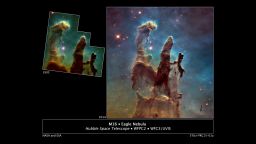Story highlights
A 1995 image of the "Pillars of Creation" became iconic
The new images give an even more spectacular view -- and new insight
NASA has come out with a new image that could become one of its most iconic ever.
The Hubble Space Telescope revisited the so-called “Pillars of Creation,” which the space agency describes as “three giant columns of cold gas bathed in the scorching ultraviolet light from a cluster of young, massive stars in a small region of the Eagle Nebula, or M16.”
The previous photo of these pillars, taken in 1995, went on to stand out from all the rest of NASA’s space images, the agency said. “The Hubble image is so popular that it has appeared in movies and television shows, on T-shirts and pillows, and even on a postage stamp.”

In celebration of the telescope’s upcoming 25th anniversary in April, Hubble returned to the pillars – and this time with the latest high-definition tools.
The new sharper and wider image was taken “in near-infrared light, as well as visible light,” NASA said. “The infrared view transforms the pillars into eerie, wispy silhouettes seen against a background of myriad stars. That’s because the infrared light penetrates much of the gas and dust, except for the densest regions of the pillars. Newborn stars can be seen hidden away inside the pillars.”
In 1995, the captured image gave insight into star formation. “Nebulous star-forming regions like M16 are the interstellar neon signs that say, ‘We just made a bunch of massive stars here,’” said Paul Scowen of Arizona State University, who helped lead the original observations, in a post on NASA’s website.
The new image “hints” that these columns “are also pillars of destruction,” NASA said.
“The ghostly bluish haze around the dense edges of the pillars is material getting heated up and evaporating away into space,” said Scowen. “We have caught these pillars at a very unique and short-lived moment in their evolution.”
































































